Puerto Rico is a place of stunning natural beauty, lively music, friendly people, and delicious food. Our food is a lot like the culture it comes from: humble and unassuming in nature and yet an enormous source of pride.
Borikén, as the main island was named by its original inhabitants, is full of unique charm, but it’s also interesting for the commonalities it shares with its close neighbors in the Greater Antilles, the Dominican Republic and Cuba. Everything about these islands—from the music to the folklore and the very DNA of the people—has been shaped by the influence of three peoples: the indigenous Taino, the Spanish colonizers, and the West Africans brought by force through the transatlantic slave trade to replace the eradicated natives. It’s a story of suffering and loss that human resilience has made into a proud and strong heritage. We call Puerto Rican cuisine cocina criolla (Creole cooking), a name that keeps us forever mindful of these roots.
Because of the shared history and natural resources of the Hispanic islands of the Caribbean, the cuisines we developed are pretty similar. They share a Spanish base and are heavy on meat, garlic, olive oil, and rice. Crops from West Africa like tamarind, pigeon peas, and (perhaps most important) plantains were later introduced and enjoyed throughout the Caribbean. Starchy and firm when green (as in the international hit tostones), soft and sweet when ripe (as in deep-fried, mushy, sweet maduros), plantains are versatile. It’s easy to see how they became a regional staple. And we all use the many native plants favored by the Taino—spices like recao (long coriander) and achiote (bijol), fruits like guayaba (guava) and guanábana (unappetizingly called “soursop” in English), as well as yuca (cassava), which was later joined in the canon by other root vegetables from Africa, like ñame (yam).
Yet our cuisines distinguish themselves from all others in the aspect that matters most: el sazón. That’s the seasoning. The flavor. As a person who grew up with just one type of cooking, it’s very difficult to explain exactly where the difference from the others lies, but we all know the flavor of home when we taste it. As with our dialects, which can sound the same even to non-Caribbean Latin Americans, we always recognize our own.
A fundamental part of sazón is el sofrito. This sauteed, pastelike concoction is the basic building block of every sauce, stew, or soup we make. Every cook makes it differently, but it generally contains olive oil; garlic; onion; cubanelle, ajicito, and other peppers; bijol; capers; bay leaf; cumin; a number of herbs like oregano, cilantro, recao, and whatever else your family tradition or whim dictates. We often keep the store-bought version handy, but when we have the time, we like to make a large batch and freeze it for convenience. So important is el sofrito to the Puerto Rican kitchen that our neighbors who didn’t have generators would come by during a power outage to ask us to store it for them.
Any dish will also need an almost unreasonable amount of salt, which is why adobo seasoning and “cubitos Knorr” (our preferred brand of cubed chicken bouillon) are indispensable in the Caribbean cupboard.
I don’t expect anyone to keep this dizzying array of ingredients straight, but you now have an idea of how complex the resulting flavors are and what the capacity for variety is. Sazón is so essential to us that we use the word when speaking of music, dancing—our very taste for life. It is everything.
Lechón a la varita
The quintessential Puerto Rican meal is centered around lechón a la vara—whole roasted pork on a spit. This image might register as a cartoonish sight for most people, but if you’re from Puerto Rico, it will instantly bring you back to every major family gathering you’ve ever had. While the grown-ups sip beer and moonshine rum, the children vie for the crunchiest, fattiest pieces of el cuerito, the pork’s crackled skin.
Expectations are high after such a grandiose presentation, but what you find underneath that crunchy, fatty rind will in no way disappoint. The religious attention paid to seasoning and preparation means that even the lightest meat comes out miraculously moist, and the dark meat falls off the bone at the gentlest prodding.
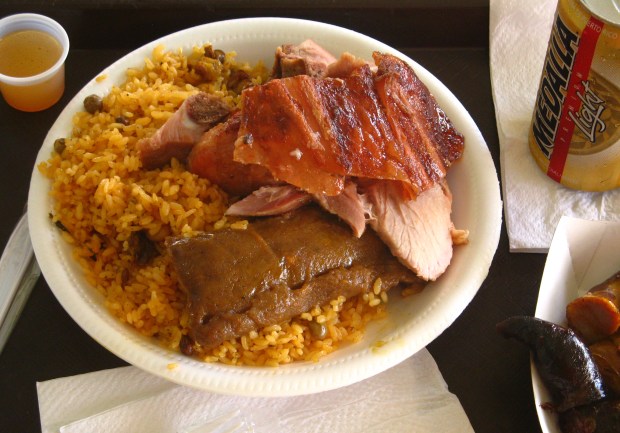
While the meat is definitely the star of the show, rest assured that no part of the animal goes to waste. Its blood is mixed with rice and spices for morcilla (blood sausage); its tripe goes into a stew called gandinga; its bones, brains, and cuajo (stomach) go into many soups and stews; and patitas de cerdo (pig’s feet) are prepared in various ways. This careful consumption extends to chicken and beef as well. In fact, beef-tongue steak, with its rich, meaty flavor and melt-in-your-mouth texture, is one of my favorite traditional dishes.
Obviously, a community effort is required to pull off—not to mention eat—a whole roasted pork, so we most often enjoy it at country restaurants called lechoneras. An equally satisfying alternative is pernil (roasted pork shoulder), which can be made in your home oven.
Mofongo
This hearty mound of mashed plantain is the signature dish of Puerto Rico. Its Boricua origins are undisputed, and it might be our most internationally known menu item. The pilón (mortar) used to make it is yet another contribution from Taino culture. It is so iconic that miniature models emblazoned with “Puerto Rico” are available in every souvenir shop.
Cuba has fufu de plátano and the Dominican Republic has mangú. They’re similar, but the difference is in the cooking method: mofongo is only fried, never boiled.
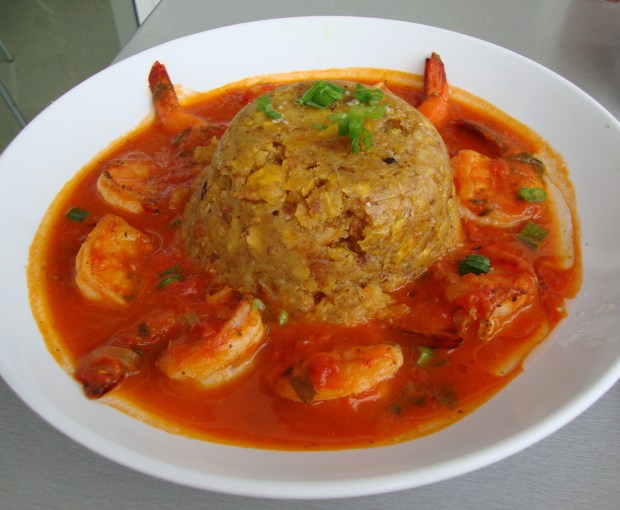
The elaboration of mofongo begins like that of tostones, by cutting green plantains into rounds and frying them. But instead of being flattened in a tostonera and fried once more, the plantain chunks are combined in the mortar with chicharrón (fluffy fried pork rinds, an immensely popular Latin snack), your preferred flavorings (tons of garlic or bust!), and a bit of oil or fat to soften the mixture. All of these ingredients are pounded together with the maceta (pestle) until a soft yet lumpy mash is achieved. The concept is much like mashed potatoes, but its consistency is much firmer and chewier, as all of the plantain’s starch—and character and flavor—is retained rather than lost in discarded boiling water.
There are many ways to eat mofongo: al ajillo (in garlic sauce), with mayoketchup (exactly what it sounds like, but with garlic and a little lemon juice), or moistened with mojo isleño (a tomato-based sauce). In my family we sometimes like to eat it with Argentine chimichurri (did I mention we like garlic?). A wildly popular variant is mofongo relleno (stuffed mofongo), usually filled with shrimp or seafood stew, a sauce with shredded chicken, or beefsteak.
Mofongo is hard to resist but surprisingly filling, so you may have to summon all your willpower to keep from eating to the point of discomfort.
Pasteles
This classic dish is not very well known outside the Caribbean, but it will still seem familiar to many. It looks like a slightly larger version of the Mexican tamale, but don’t be fooled. Instead of corn, the dough is made with either green banana or cassava, which gives it a more cohesive and creamier texture than the crumbly, powdery one tamales tend to have.
There’s another crucial difference: They’re never spicy. Contrary to the common assumption, there is no traditional Puerto Rican dish that is. Boricuas abroad are so tired of this stereotype that the quickest way to annoy us (after asking about our U.S. visa status) is to express complete and utter shock if we turn down spicy food. Even my sweet angel of a mother struggles to hide her anger when she has to explain for the millionth time, “We like spices, not spicy”. As much as we love and respect our Mesoamerican friends, we don’t appreciate having our culture conflated with theirs.
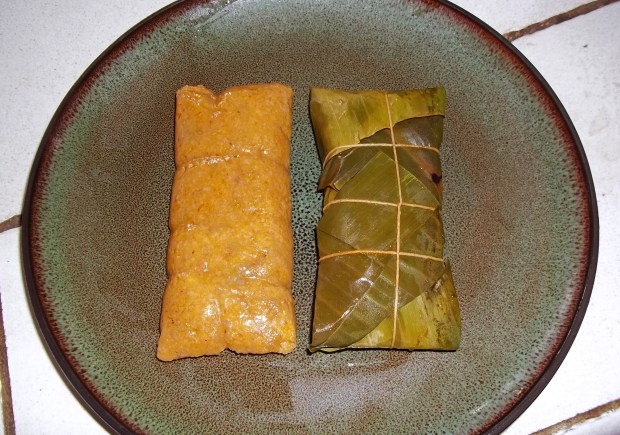
This might be especially true for pasteles, as they’re among our most beloved foods and carry tremendous significance for us. They’re particularly enjoyed during the holiday season, which is a time we dedicate to the celebration of traditional jíbaro mountain culture.
Pasteles are wrapped in banana leaves, so you can’t tell which are made with green banana or cassava doughs and which are filled with sauteed chicken, pork, or other meats. For this reason, they’re tied with color-coded strings for easy identification. My own favorite is cassava with chicken—the green string, at least in our household.
They’re very time intensive to make, so many city dwellers like us buy them premade from a home cook with that magic touch. And because they take an hour to cook, pulling a yunta (set of two) out of the boiling water, cutting the string, carefully unwrapping one pastel, slicing a soft, warm piece with the side of your fork, and taking a savory bite is a very special kind of happiness.
Pasteles are not lacking for flavor by any means, but we still like to drown them in ketchup. Don’t judge.
Arroz con …
Many Boricuas eat rice and beans every single day. People are sometimes surprised to hear that arroz con habichuelas was served as an accompaniment to virtually every school cafeteria lunch I had as a kid.
The words rice and beans mostly call to the Puerto Rican mind a specific dish that consists of white rice with a tomato-based bean sauce poured on top. This sauce is usually made with pink, kidney, or white beans and tends to contain cooking ham, stock, and vegetables like calabaza (calabash). Arroz mamposteao is similar, with the rice-and-bean sauce cooked together, resulting in a yellow color and a drier mouthfeel. The same goes for arroz con garbanzos (chickpeas), arroz con lentejas (lentils), and arroz con gandules (pigeon peas), the last of which is of known Puerto Rican origin. Black beans are less common, used more in Dominican or Cuban cuisine.
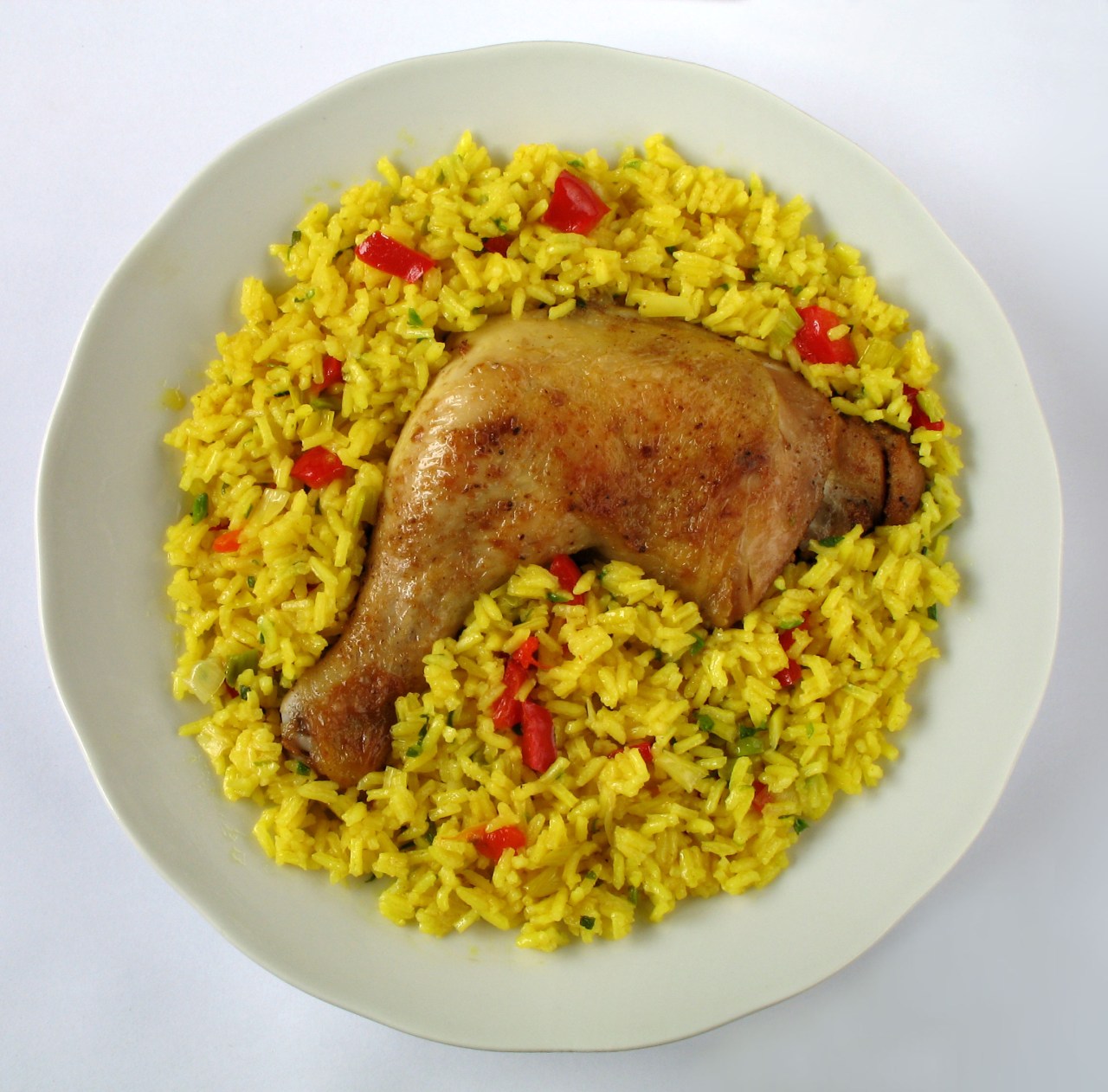
There’s also arroz con pollo, or yellow rice with chicken, another well-loved and certifiably Puerto Rican dish. Arroz con salchichas, or yellow rice with Vienna sausages (yes, the little canned ones), is one you may not find at a high-end restaurant, but it’s guaranteed to be in the regular rotation of any given Puerto Rican home. Asopao, which could be clumsily transliterated as “souped” rice, is another household favorite. Asopao de camarones (shrimp) is my absolute favorite soup. I’m generally a slow eater, but I make an exception for asopao because otherwise the rice absorbs all of the liquid and becomes more porridge than soup.
Rice is often overlooked as a bland complement to a more flavorful entree, but to the Puerto Rican cook, it’s a perfect canvas to showcase all the flavor we have to offer.
Mariscos
I’ve always found it ironic that while the general perception of Puerto Rico consists solely of beautiful beaches, its variety of seafood is rarely mentioned.
Most of the fish we eat are found in our warm waters, with the glaring exception of codfish, which came to us as an age-old Spanish favorite. There’s no end to the available selection of local fish, but it includes dorado (dolphinfish), mero (grouper), sierra (a kind of mackerel), and chillo (red snapper).
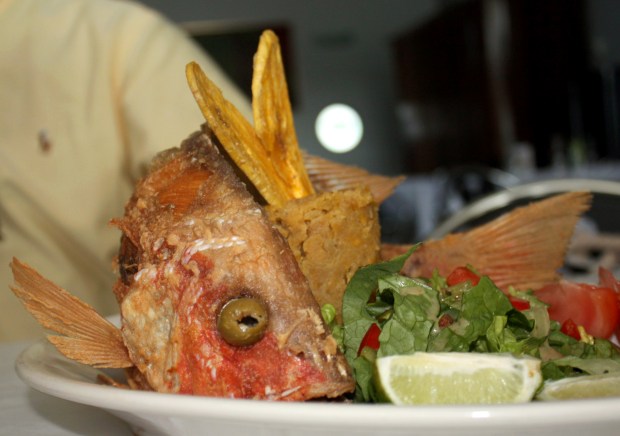
Lightly battered and deep-fried chillo is my favorite cooked fish. It’s hefty enough that it can be fried until dark brown and very crispy without sacrificing the juiciness of the meat. The head is rarely neglected: My sisters and I used to argue about who got to eat a cheek and who had to eat an eye. Luckily, I was the only one who liked eating the crunchy fins.
Aside from the usual fish, squid, and shrimp, pinchos de marlín (meat-only kebabs of swordfish) and shark meat are found in many kioskos as well. Picúa (barracuda) is another local delicacy, but precautions must be taken against ciguatera, an illness caused by a toxin that builds up in the apex predators of tropical waters. Carrucho (conch) is hard to come by elsewhere, but it’s a mainstay in the Caribbean. My favorite seafood dish is a salad made with conch, octopus, and onions in a Spanish-style olive oil and vinegar-based sauce.
Piragüas
Out in the town on a hot and muggy day fewer sights are more welcome than a piragüa cart.
In a uniquely Puerto Rican tradition, the piragüero walks near parks and places where families gather with a roofed pushcart carrying an enormous, solid block of ice and an assortment of sugary syrup flavorings. These include flavors tourists will find familiar (cherry, orange, grape, coconut, and cream) and many that might appeal only to locals (soursop, tamarind, sesame, and melao de caña, or sugarcane syrup). Once you’ve made your selection, he’ll grab his ice shaver (a tool resembling a plane, with a cartridge on top to contain the ice as it’s shaved) and get to work making enough slushy ice to deposit inside your cup for a towering ice mountain. Then he’ll give it a generous pour of your choice of syrup.

A more relaxed spinoff that requires no special tools and zero elbow grease is called limber. The syrup is mixed with water (or milk, depending on the flavor), poured into a plastic cup and frozen. Squeezing the cup pushes the limber up and out to be licked like an ice pop; the cup catches the melt, so it’s a treat with no fuss and no muss. When I was growing up—I hope it’s still so—preparing limber to sell out of one’s window to children on their way home from school was a common side hustle for homemakers and retired women. At first they’d put out a sign, but after a few months it would no longer be necessary. Every self-respecting kid knew where to find la señora de los limbers in their neighborhood.
Postres
All of the desserts that truly represent Puerto Rico are derived from recipes that have existed in Spain since time immemorial. Some are virtually crystallized, hardly changed at all, while others have a decidedly Caribbean twist.
Spanish flan is king of the dessert menu in Puerto Rico. At any given restaurant you’re bound to find at least one choice from original, coconut, cream cheese, or guava. You could also find one when you visit abuelita.

Another Spanish sweet we’ve kept largely unchanged over the centuries is mallorca, sweet rolls made with pork lard known in the old country as ensaïmada. Boricuas serve it two ways: fresh out of the oven so as to best appreciate its soft and supple consistency, with powdered sugar sprinkled on top; or pressed in a warming grill with lots of butter for a chewier experience.
Other bakery selections include my personal favorite, quesito—somewhat like soft cannolis, filled with sweetened cream cheese—and pastelillos de guayaba—puffy, flaky pastries with a filling of guava paste (itself a stand-alone dessert offering), often combined with sweetened cream cheese, always topped with a thick dusting of powdered sugar. Whenever my dad stopped by the bakery to pick up a loaf of bread, he always remembered to bring me a quesito.
Bakeries and restaurants often sell a curious little item called tierrita. It’s a vanilla or chocolate mousse that earns its name, “little dirt,” by being served in a miniature flowerpot, covered with a surface layer of finely crumbled chocolate cookies, and decorated with little plastic flowers.
One of our signature desserts is arroz con dulce, a tropical riff on Spain’s arroz con leche. It is an exquisitely creamy rice pudding made with coconut, raisins, and a number of spices like cinnamon, cloves, vanilla, and nutmeg.
Tembleque is our take on custard pudding, also made with coconut and always dusted with cinnamon powder. It has a more even and gelatinlike consistency than that of flan. Its jello-esque jiggle inspired its name, which means “shaking” or “quaking.”
Arroz con dulce and tembleque are particularly ubiquitous during the holidays.